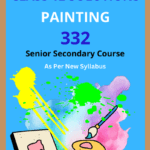NIOS Class 12 Painting Chapter 7 Mughal School Solutions to each chapter is provided in the list so that you can easily browse throughout different chapters NIOS Class 12 Painting Chapter 7 Mughal School and select need one. NIOS Class 12 Painting Chapter 7 Mughal School Question Answers Download PDF. NIOS Study Material of Class 12 Painting Notes Paper 332.
NIOS Class 12 Painting Chapter 7 Mughal School
Also, you can read the NIOS book online in these sections Solutions by Expert Teachers as per National Institute of Open Schooling (NIOS) Book guidelines. These solutions are part of NIOS All Subject Solutions. Here we have given NIOS Class 12 Painting Chapter 7 Mughal School, NIOS Senior Secondary Course Painting Solutions for All Chapter, You can practice these here.
Mughal School
Chapter: 7
PAINTING
Bird Catching at baran (Pic. 20)
| Title | Bird Catching at Baran |
| Artist | Bhag |
| Medium | Tempra |
| Period | Akbar |
| Style | Miniature |
| Collection | National, Museum, New Delhi |
Manuscripts illustrated by the painters of the court of Akbar were the Akbar Nama, the Razam Nama (the Persian translation of the Mahabharata), Anwar-i-Suhayli, a book of fables and Babur Nama. The painting Bird Catching at Baran from Babur Nama has special mention. This painting in tempera technique was made on paper by Bhag. The painting consists of natural surroundings. A bird catcher had spread a net under a tree and is hiding behind the tree and covered himself with a red screen. In the foreground a pond is full of lotus flowers where a pair of hoopoes, sarus, snippets, duck and other birds are drinking water. Few birds have fallen prey in the net. Indeed, this is a very beautiful study of birds. The appearance and color of birds, trees, flowers and mountains are quite natural, which is a characteristic of Akbar period.
Jahangir Holding a Picture of Madonna (Pic. 21)
| Title | Jahangir holding a picture of Madonna |
| Artist | Abul Hasan |
| Medium | Tempera |
| Period | Jahangir |
| Style | Miniature |
| Collection | National Museum, New Delhi |
Abul Hasan made portrait of Jahangir holding a picture of Madonna in 1620. This painting is also done in tempera technique. Jahangir is shown holding a picture of Madonna and looking closely at it. Jahangir is painted in the middle with decorated borders with scripture on some of it. This painting has an influence of western style. The portrait in profile has prominent nose, big head, soft colors and golden appearance, which is the main characteristics of Jahangir school.
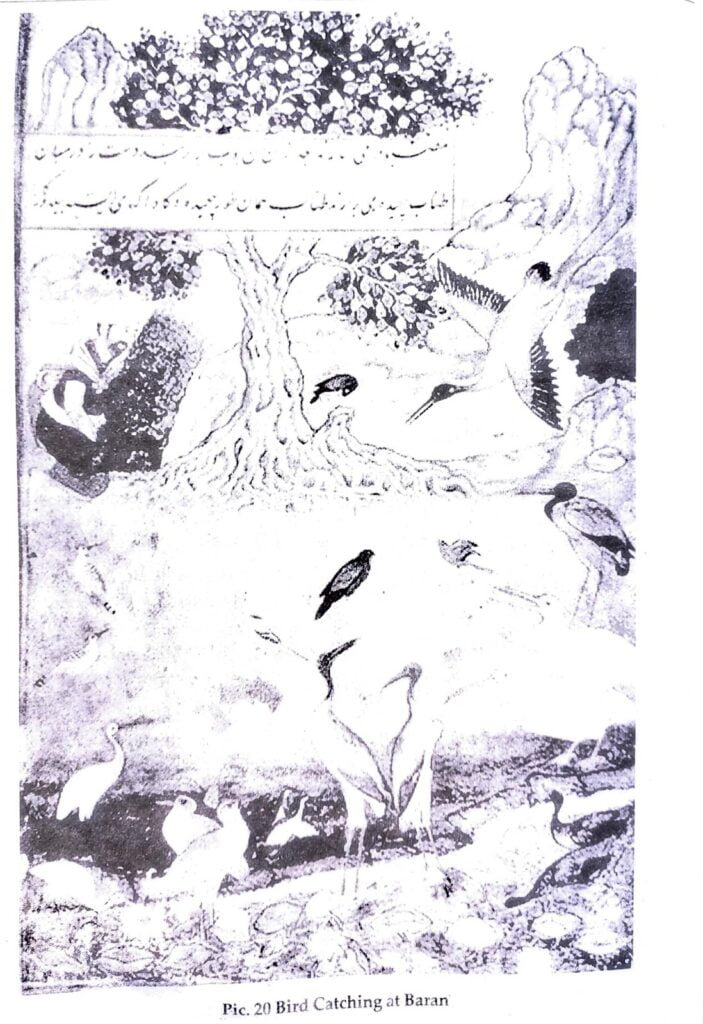
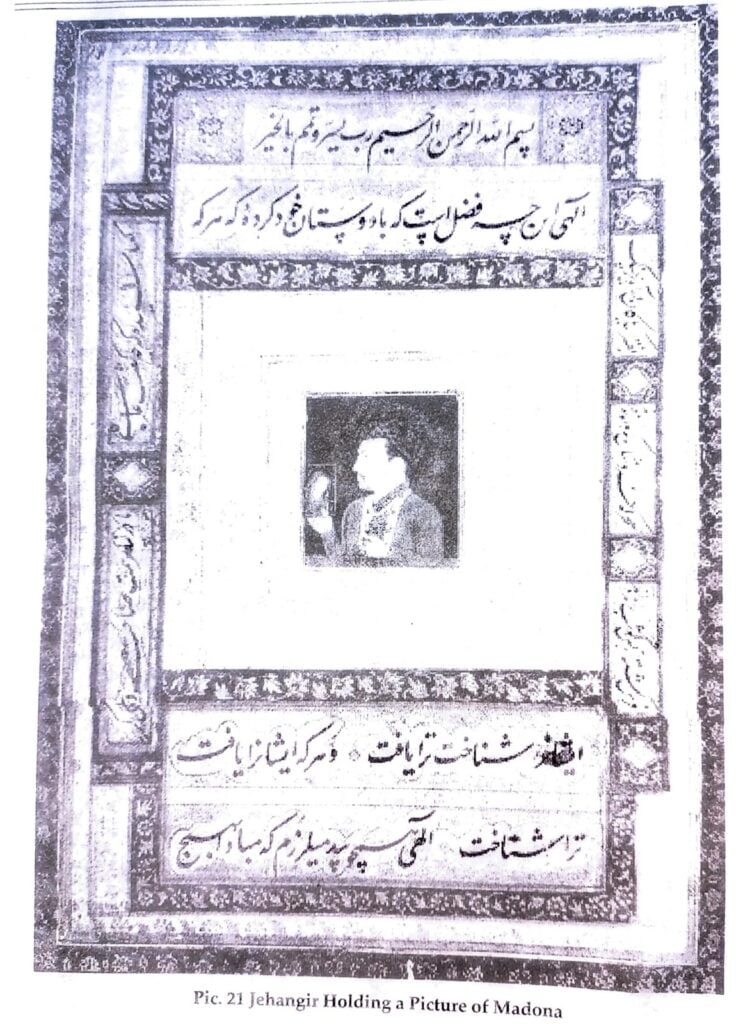
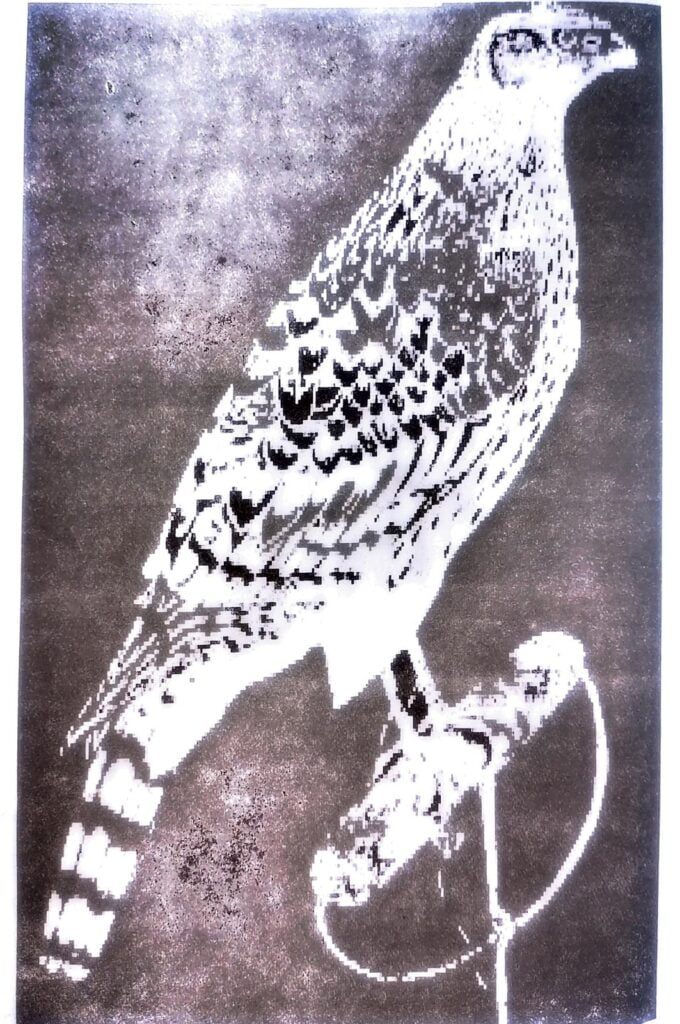
Pic 22 Falcon on a Bird Rest
| Title | Falcon on a Bird Rest |
| Artist | Ustad Mansur. |
| Medium | Tempera |
| Style | Miniature |
| Time | Jehangir |
| Collection | National, Museum, New Delhi |
Ustad Mansur was one of the famous painters in Jehangir court. He was mainly known for his wonderful studies of bird life but he was also one of the best Mughal portrait painter. There was no doubt the practice of drawing from live model popular during Jehangir which led to remarkable achievement in portraiture. ‘Falcon on a Bird Rest’ is a best example of Ustam Mansur’s work. Detailed study of Falcon is quite noticeable in this painting. It seems that this falcon is a tamed bird and painted in tempera technique with realistic details. The falcon is painted in white and brown colours against a contrast yellow background. Its sharp beak and round vigilant eyes are in shades of deep yellow ochre. A patch of light blue delineates the feathers on the back of its neck. The bird is fastened with a weight and a sting hanging beautifully around its neck. Probably this falcon was a gift from Shah Abbas, the emperor of Iran.
Kabir and Raidas (Pic. 23)
| Title | ‘Kabir and Raidas’ |
| Artist | Faqir-Ullah |
| Medium | Tempera |
| Style | Miniature |
| Period | Shah Jahan |
| Collection | National Museum, New Delhi |
The period of Shah Jahan was an age of gold. But during his time miniature paintings first shows the sign of decline. The works are perfect but without any life.
Under Shah Jahan the pattern set during Jahangir was followed in both miniatures and manuscript illustrations. Portraits continued to acquire much of the time of the court painters. There was more feminine touch, an added softness in the drawing of portraits. A new tendencies of naturalism in figure drawing and realistic drapery evolved.
The painting ‘Kabir and Raidas’ is a documented evidence of respect given to religious saints by Mughals. Ustad Fakir-Ullah made this tempera painting on paper. He was the head painter of Shah Jahan’s Workshop. In a rural background saint Kabir is painted, besides his hut, weaving. The portraits of Kabir and Raidas are realistic drawing, while the background fades in the mist. Saint Raidas is sitting near by with a mala of beads. Both are shown to be in deep meditation. There is a divine peace on their faces. This painting shows simple and peaceful life in Indian village. A blue border highlights the painting which is painted in brown shades.
Marriage procession of Dara Shikoh. (pic. 24)
| Title | “Marriage Procession of Dara Shikoh |
| Artist | Haji Madani |
| Medium | Tempera |
| Style | Miniature |
| Time | Awadh school |
| Collection | National Museum, New Delhi |
Provincial art in Awadh became very developed under Nawab Shuja-ud-Daula. It reached at its zenith under Wajid Ali Shah. While keeping the basic Mughal style, the Awadh school developed a new style. There was huge emphasis on decoration and color were softer.
‘Marriage Procession of Dara Shikoh’ was made by Haji Madani on paper in tempera technique. In this painting Dara Shikoh with his baratees is riding on horse back. The prince is leading the procession. There are joyful men, women and young boys who are mainly waiting for them. Dara Shikoh is wearing an angrakha and a veil of pearls. His father Shah Jahan has a halo around his head follows him. All the faces are shown either in profile or semi profile. The women are riding on elephants in
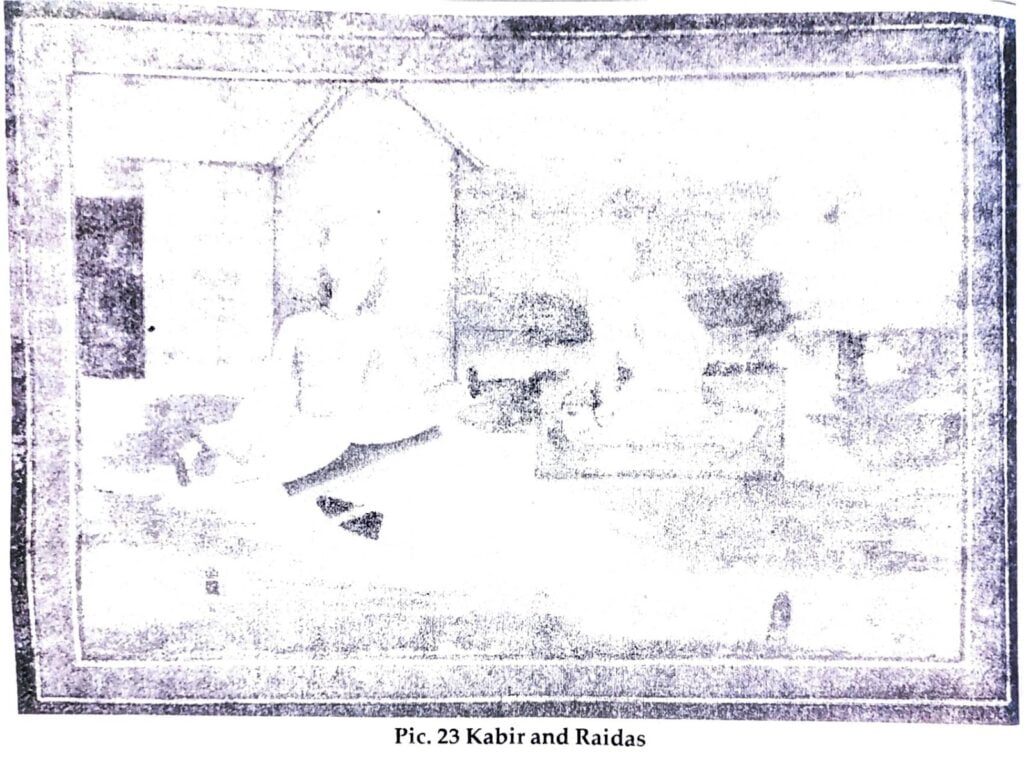
the background. Alongside the drummer are beating their drums sitting on elephants. The dancing, clapping and singing crowds are wearing bright colourful clothes decorated with gold. Some of the men from both the sides are holding candles. The perspective in the painting is maintained diligently. This painting depicts all flora and fauna.
Intext Questions 7.1
Fill up the blanks:
1. Razam Nama was illustrated during the period of __________.
Ans: Akbar.
2. Bird catching at Baran was done in technique __________.
Ans: Tempera.
3. The name of artist of this painting is __________.
Ans: Bhag.
Intext Questions 7.2
Mark against correct answer of the following questions:
1. Jahangir holding the picture of Madonna is painted by
(a) Ustad Mansur.
(b) Abul Hasan.
(c) Abdul Samad.
Ans: (a) Ustad Mansur.
2. The portrait of Jahangir was done in:
(a) Profile.
(b) Front.
(c) Semi-profile.
Ans: (a) Profile.
3. The portrait has
(a) Prominent ear.
(b) Prominent eye.
(c) Prominent nose.
Ans: (c) Prominent nose.
Intext Questions 7.3

Pic 24 Marriage procession of Dara Simon
Mark against correct answer of the following questions:
1. Falcon on a bird rest is a painting in
(a) Realistic style.
(b) Abstract style.
(c) Semi realistic style.
Ans: (a) Realistic style.
2. The falcon is painted in
(a) Red and blue colors.
(b) Brown and white colors.
(c) Brown and Red colors.
Ans: b. Brown and white colors.
3. Ustad Mansur was chiefly known for his
(a) Landscape study.
(b) Bird life study.
(c) Foliage study.
Ans: (b) Bird life study.
4. Practice of drawing from living model was familiar during
(a) Akbar period.
(b) Jehangir period.
(c) Humayun period.
Ans: (b) Jehangir period.
Intext Questions 7.4
Circle the correct answer of the followings:
1. The border of the painting is painted in
(a) Blue shades.
(b) Green shades.
(c) Brown shades.
Ans: (c) Brown shades.
2. ‘Kabir and Raidas’ was painted by
(a) Fakir-Ullah.
(b) Nadir.
(c) Mansoor.
Ans: (a) Fakir-Ullah.
3. The period of Shah Jahan was the period of
(a) Bronze.
(b) Silver.
(c) Gold.
Ans: (a) Bronze.
Intext Questions 7.5
Fill up the blanks:
1. Marriage Procession of Dara Shikoh is painted by __________.
Ans: Hazji Madani.
2. Shah Jahan is shown with a __________ around his head.
Ans: Halo.
3. Women are shown riding on __________.
Ans: Elephants.
4. Provincial art reached at its peak under __________.
Ans: Wajid Ali Shah.
Model Questions
1. Write the technique used in miniature painting.
Ans: Miniature paintings are small format of paintings which were usually executed with minute details. Paper was carefully burnished and preliminary drawing was made with red ink. Then the paper was coated with thin wash of white pigment. On this surface painting was done with tempera colors. Finally gold was used where necessary and complete painting was again burnished.
2. Describe the painting ‘Falcon on the bird rest’.
Ans: Ustad Mansur was one of the notable painters in Jehangir court. He was chiefly known for his wonderful studies of bird life but he was also one of the best Mughal portrait painter. There was no doubt the practice of drawing from live model familiar during Jehangir which led to remarkable achievement in portraiture. “Falcon on a Bird Rest’ is a superb example of Ustam Mansur’s work. Detailed study of Falcon is easily noticeable in this painting. It seems that this falcon is a tamed bird and painted in tempera technique with realistic details. The falcon is painted in white and brown colors against a contrast yellow background. Its sharp beak and round vigilant eyes are painted in shades of deep yellow ochre. A patch of light blue delineates the feathers on the back of its neck. The bird is fastened with a weight and a sting hanging beautifully around its neck. Probably this falcon was a gift from Shah Abbas, the emperor of Iran.
3. Write the characteristics of Mughal Miniature painting.
Ans: Mughal evolution of miniature paintings originated in Persia and continued for about three centuries in India. The tradition of miniature painting went on from one generation to another with fresh touch. The first Mughal emperor of India was Babur who was a man of aesthetic sensibilities. His son Humayun patronized the art of miniature painting and brought a few Persian artists of India. Notable names were Abdul Samad and Mir Sayyid Ali. It was from these artists that Humyun and his son Akbar took lessons in drawing.
4. Write on painting done during Shah Jahan’s period.
Ans: The period of Shah Jahan was an age of gold. But during his time miniature paintings first shows the sign of decline. The works are perfect but lifeless.
Under Shah Jahan the pattern set under Jahangir was followed in both miniatures and manuscript illustrations. Portraits continued to occupy much of the time of the court painters. There was more feminine touch, an added softness in the drawing of portraits. A new tendencies of naturalism in figure drawing and realistic drapery was developed.
The painting ‘Kabir and Raidas’ is a documented example of respect given to religious saints by Mughals. Ustad Fakir Ullah did this tempera painting on paper. He was the head painter of Shah Jahan’s Workshop. In a rural background saint Kabir is painted, besides his hut, weaving. The portraits of Kabir and Raidas are realistic study, while the background fades in the mist. Saint Raidas is sitting close by with a mala of beads. Both are in deep meditation. There is a divine peace on their faces. This painting brings forth the simple and peaceful life in Indian village. A blue border focuses the painting which is painted in brown shades.
5. Describe the painting ‘Marriage Procession of Dara Shikoh’.
Ans: Provincial art in Awadh became very powerful under Nawab Shuja-ud-Daula. It reached at its peak under Wajid Ali Shah. While keeping the basic Mughal style, the Awadh school developed a style of its own. There was tremendous emphasis on decoration and colour were softer.
‘Marriage Procession of Dara Shikoh’ was painted by Haji Madani on paper in tempera technique. In this painting Dara Shikoh with his baratees is riding on horse back. The prince is leading the procession. There are joyful men, women and young boys who are largely waiting for them. Dara Shikoh is wearing an angrakha and a veil of pearls. His father Shah Jahan who is shown with a halo around his head follows him. All the faces are shown either in profile or semi profile. The women are shown riding on elephants in the background.. Alongside the drummer are beating their drums sitting on elephants. The dancing, clapping and singing crowds are dressed in bright colourful clothes decorated with gold. Some of the men from both the sides are holding candles. The perspective in the painting is maintained carefully. This painting depicts all flora and fauna.
Very Short Type Questions Answer
1. Where did Mughal miniature painting originated?
Ans: Mughal miniature originated in Persia.
2. Under which Mughal king major works of Mughal miniature start?
Ans: The first major works of Mughal miniature were probably begun under Humayun but was completed under Akbar.
3. Name three main painters of Mughal period.
Ans: Farukh Baigh, Aqua Raja, and Ustad Mansur were main painters during his period.
4. Which manuscripts were illustrated by the painters of the court of Akbar?
Ans: Anwar-i-Suhayli, Akbar Nama,Razam Nama and Babur Nama.
5. Which painter did portrait of Jahangir holding a picture of Madona in 1620?
Ans: Abul Hasan in 1620.
6. Who painted Falcon on A bird Rest?
Ans: Ustad Mansur.
7. Under which Mughal king miniature painting first shows the sign of decline?
Ans: During Shah Jahan period.
8. What new change take place in Mughal miniature during Shah Jahan period?
Ans: A new tendency of naturalism in figure drawing and realistic drapery was developed.
9. What type of medium was used in the painting of Dara Shikoh?
Ans: Tempera.
10. To which school the painting ‘Marriage a Procession of Dara Shikoh belong’?
Ans: Awadh school.
Short Type Questions Answer
1. How Mughal miniature painting developed during various Mughal kings?
Ans: The first major works of Mughal miniature were probably begun under Humayun but was completed under Akbar. During his period miniature paintings were F lively and realistic and even contain elements of individual portraiture. After Akbar, his son Jehangir became the emperor. In his time mughal paintings achieved its zenith, both as decorative art and the nature study. Farukh Baigh, Aqa Raja, and Ustad Mansur were main painters during his period. Miniature paintings of the court of Jehangir’s son, Shah Jahan show the first sign of decline.
2. Describe the painting “Bird catching at Baran”.
Ans: Manuscripts illustrated by the painters of the court of Akbar were the Akbar Nama, the b Razam Nama (the Persian translation of the Mahabharata), Anwar-i-Suhayli, a book of fables and Babur Nama. A painting Bird Catching at Baran from Babur Nama has special mention. This painting in tempera technique was done on paper by Bhag. The painting is full of na ural surroundings. A bird catcher had spread a net under a tree and is hiding behind the tree and covering himself with a red screen. In the foreground a pond is full of lotus flowers where a pair of hoopoes, sarus, snippets, duck and other birds have gathered to drink water. Few birds have fallen prey in the net. Indeed, this is a very beautiful study of birds. The appearance and color of birds, trees, flowers and mountains are quite natural, which is a speciality of Akbar period.
3. Describe the painting “Jahangir Holding A Picture of Madonna”.
Ans: Abul Hasan did portrait of Jahangir holding a picture of Madonna in 1620. As tempera of paper was common in practice, this painting is also done in same technique. Jahangir is shown holding a picture of Madona and having a close look at it. Jahangir is painted in the Centre with decorated borders with scripture on some of it. This painting has an influence of western style. The portrait in profile has prominent nose, big head, soft colours and golden appearance, which is the main characteristics of Jehangir school.
4. Describe the painting “Falcon On A Bird Rest”.
Ans: Ustad Mansur was one of the notable painters in Jehangir court. He was chiefly known for his wonderful studies of bird life but he was also one of the best Mughal portrait painters. There was no doubt the practice of drawing from live model familiar during Jehangir which led to remarkable achievement in portraiture. ‘Falcon on a Bird Rest’ is a superb example of Ustad Mansur’s work. Detailed study of Falcon is easily noticeable in this painting. It seems that this falcon is a tamed bird and painted in tempera technique with realistic details. The falcon is painted in white and brown colours against a contrast yellow background. Its sharp beak and round vigilant eyes are painted in shades of deep yellow ochre. A patch of light blue delineates the feathers on the back of its neck. The bird is fastened with a weight and a sting hanging beautifully around its neck. Probably this falcon was a gift from Shah Abbas, the emperor of Iran.
5. Describe the painting “Kabir and Raidas”.
Ans: The period of Shah Jahan was an age of gold. But during his time miniature paintings first shows the sign of decline. The works are perfect but lifeless.
Under Shah Jahan the pattern set under Jehangir was followed in both miniatures and manuscript illustrations. Portraits continued to Occupy much of the time of the court painters. There was more feminine touch, an added softness in the drawing of portraits. A new tendencies of naturalism in figure drawing and realistic drapery was developed.
The painting ‘Kabir and Raidas’ is a documented example of respect given to religious saints by Mughals. Ustad Fakir-Ullah did this tempera painting on paper. He was the head painter of Shah Jahan’s Workshop. In a rural background saint Kabir is painted, besides his hut, weaving. The portraits of Kabir and Raidas are realistic study, while the background fades in the mist. Saint Raidas is sitting close by with a mala of beads. Both are in deep meditation. There is a divine peace on their faces. This painting brings forth the simple and peaceful life in Indian village. A blue border focuses the painting which is painted in brown shades.
6. Describe the painting “Marriage Procession of Dara Shikoh”.
Ans: Provincial art in Awadh became very powerful under Nawab Shuja-ud-Daula. It reached at its peak under Wajid Ali Shah. While keeping the basic Mughal style, the Awadh school developed a style of its own. There was tremendous emphasis on decoration and colour were softer.
‘Marriage Procession of Dara Shikoh’ was painted by Haji Madani on paper in tempera technique. In this painting Dara Shikoh with his baratees is riding on horse back. The prince is leading the procession. There are joyful men, women and young boys who are largely waiting for them. Dara Shikoh is wearing an angrakha and a veil of pearls. His father Shah Jahan who is shown with a halo around his head follows him. All the faces are shown either in profile or semi profile. The women are shown riding on elephants in the background. Alongside the drummer are beating their drums sitting on elephants. The dancing, clapping and singing crowds are dressed in bright colorful clothes decorated with gold. Some of the men from both the sides are holding candles. The perspective in the painting is maintained carefully. This painting depicts all flora and fauna.
7. Describe the development of art during Mughal period.
Ans: The first major works of Mughal miniature were probably begun under Humayun but was completed under Akbar. There were a few Persian artists along with Abdul Samad, Mir Sayyid Ali. During the period of Jehangir, the miniature painting achieved its zenith both in decorative and in study of nature. Farukh Baigh, Aqa Raja, Ustad Mansur were main painters in Jehangir’s studio. Most of the paintings were executed in tempera technique in Shah Jahan’s period. There were tremendous use of gold with lot of decoration keeping the Mughal style. The Awadh school developed a style of its own.

Hi! my Name is Parimal Roy. I have completed my Bachelor’s degree in Philosophy (B.A.) from Silapathar General College. Currently, I am working as an HR Manager at Dev Library. It is a website that provides study materials for students from Class 3 to 12, including SCERT and NCERT notes. It also offers resources for BA, B.Com, B.Sc, and Computer Science, along with postgraduate notes. Besides study materials, the website has novels, eBooks, health and finance articles, biographies, quotes, and more.


